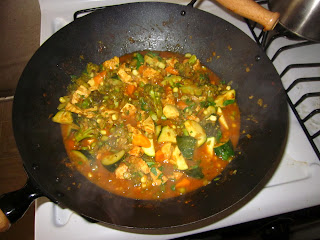The other night I had a hankering for a little Cubano flavor, and a look at the cupboard made such a thing possible. I noticed that we had a can of pinto beans and a medium sized tomato. I went to the store and saw that they had corncobs on sale for 5 for a dollar--score--and then picked up thinly sliced bone-in pork chops.
Cuban flavor can be a lot of things, like fried plantains, smoked onion remoulade, cilantro and pickled jalapeno and cabbage...but, since I didn't have many of those things, I went a little more basic: pork chops, rice and beans, and corn, all things undeniably Caribbean, or for lack of a better word, poor.
It is what it is. But with a little creativity, things can get interesting and tasty.
First I husked the corn, then put it on the stove top to char up some of the kernels. This adds a breat complexity to the flavor profile of the corn. Don't burn the kernels to their brittle and chalky black, but you dowant a little blackening. The kernels will pop and hiss. Keep a watchful eye--it'll start to smell like popcorn mixed with grilled vegetables. It's really quite pleasant.
Let it cool, then carefully slice the kernels into a bowl. Go slowly or your counters will be covered in corn. Then I cut some mirepoix, two different batches for two different projects.
I try to make a balanced meal always: a starch, a vegetable, and a protein. So for Cuban Night the protein was easy--the thinly sliced bone-in pork chops; the starch was going to be rice and beans; and the veg was going to be a play on succotash.
Succotash is a corn and bean dish, and this night I was going to make a half succotash--corn and tomato but not beans--and I added some spice and cilantro stems to the mirepoix to make it a little more Cuban.
For the rice and beans I prepped traditional mirepoix (onions, carrots, celery...and I added garlic), toasted the rice with the sauteed mirepoix, then added the beans--drained of their packing liquid--when the rice was at 90% done. It retained a traditional flavor. That's what I was going for, given the cilantro and garlic prepping for the corn.
Above you can see on the left side the rice, traditional mirepoix in a bowl, and the beans. On the right side we have the charred corn, the diced tomato, and the Cuban-style-corn-dish mirepoix. It consisted of onion, garlic, and cilantro stems. Red chili flakes get added later.
Here they both are nearly done. (Damn, my stove top needs to be cleaned.) The tomatoes add needed acidity to the corn dish (and are present in succotash as well), and I finished the it up with chopped cilantro leaves. A touch of water should be added as well, to give it something in which to cook down.
The chops were easy: seasoned well salt and pepper), they just went one at a time on the stove top, about four minutes a side, or until done. When it was all over, the pan, which was screaming hot, had a little bit of pork-ness on the bottom, a bit of stuff I removed with a healthy splash of the beer I'd been drinking. That made a little pan-sauce, which I drizzled over the finished pork chops. It was a nice addition.
Cuban Night Corn Dish
1/2 onion, small dice
2 cloves garlic, crushed and rough chopped
1/4 to 1/2 cup cilantro stems, sliced fine
5 ears of charred corn, kernels removed from cobs
1 tomato, diced medium
Start with hot oil and add onion. Saute until clear, then add garlic and cilantro stems. Season well. Once this becomes aromatic, add corn. Stir in the corn and add red chili flakes, then add around 1/4 cup water, and cover. Let simmer for two or three minutes. Add the tomato and let simmer another three or four minutes.
Don't cook too far; the corn will retain an explosiveness for a little while, but loses it as it overcooks. Check regularly and turn it off when it's to your personal liking. Once the heat's off, stir in the chopped cilantro leaves and enjoy.

























